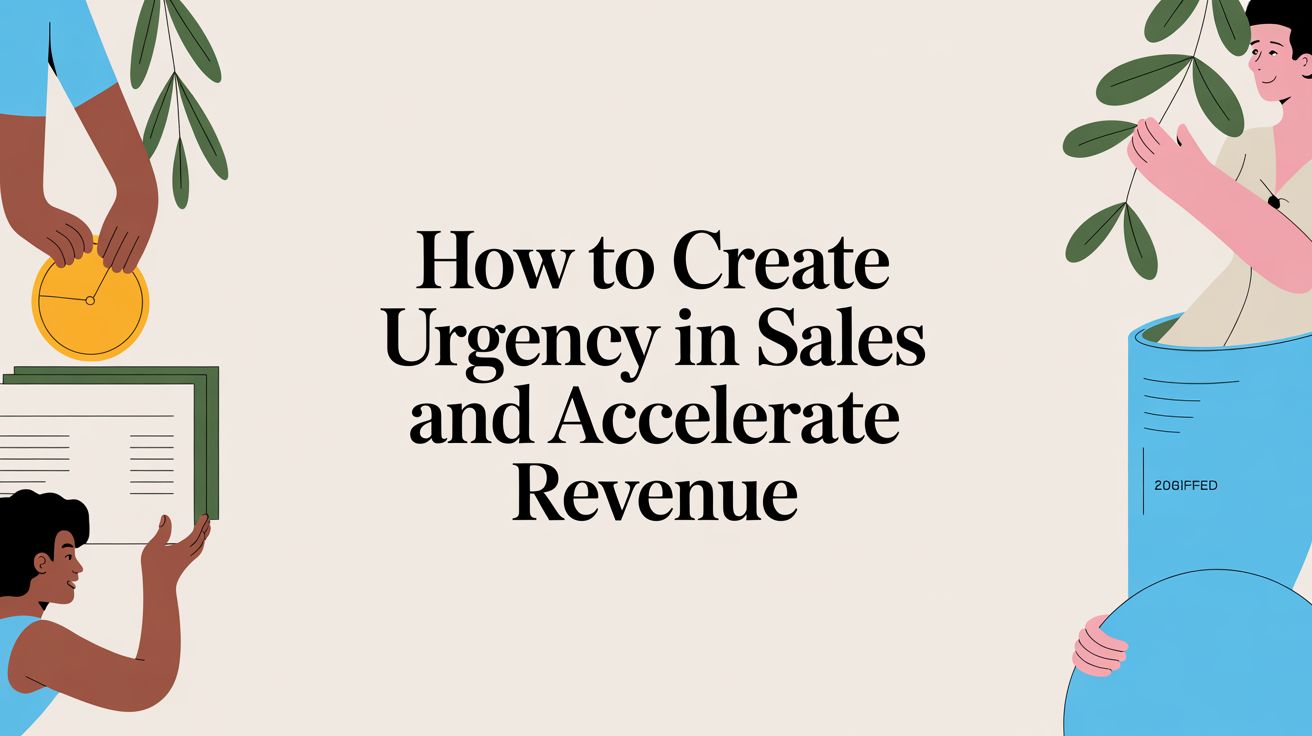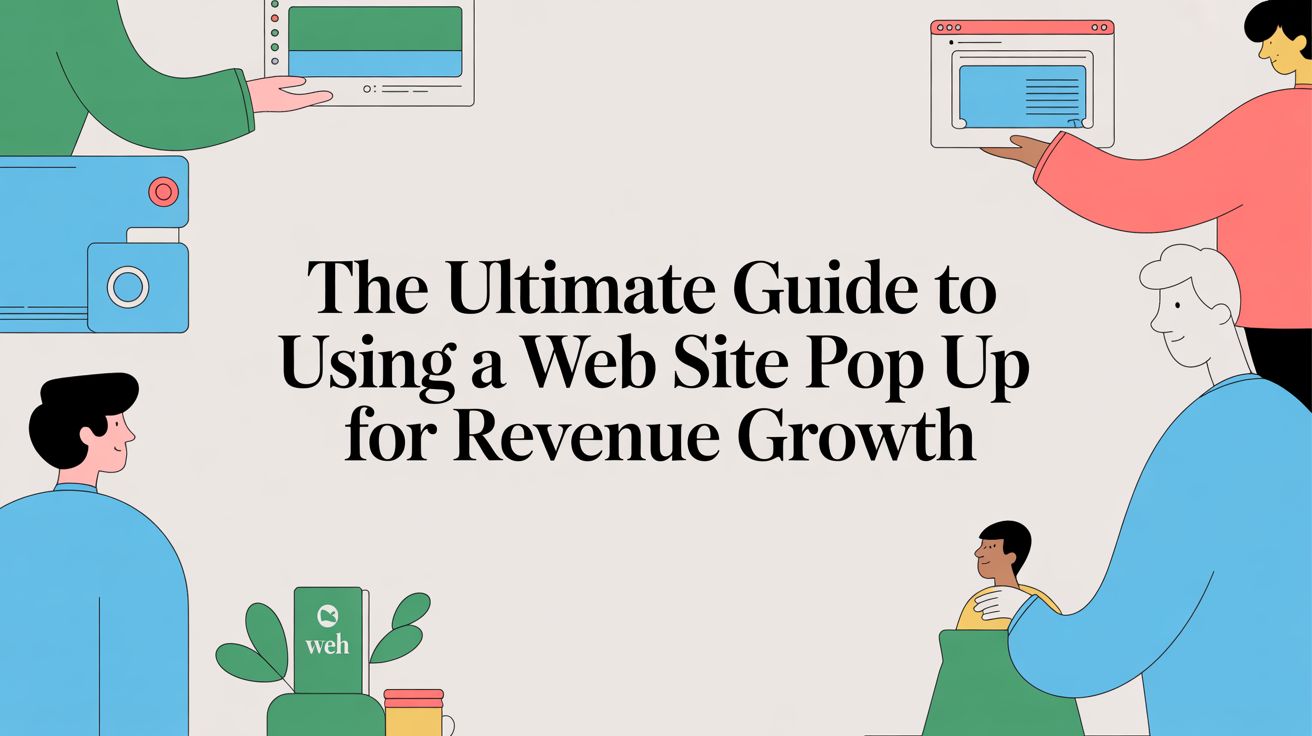
A Psychology-Based Black Friday Strategy
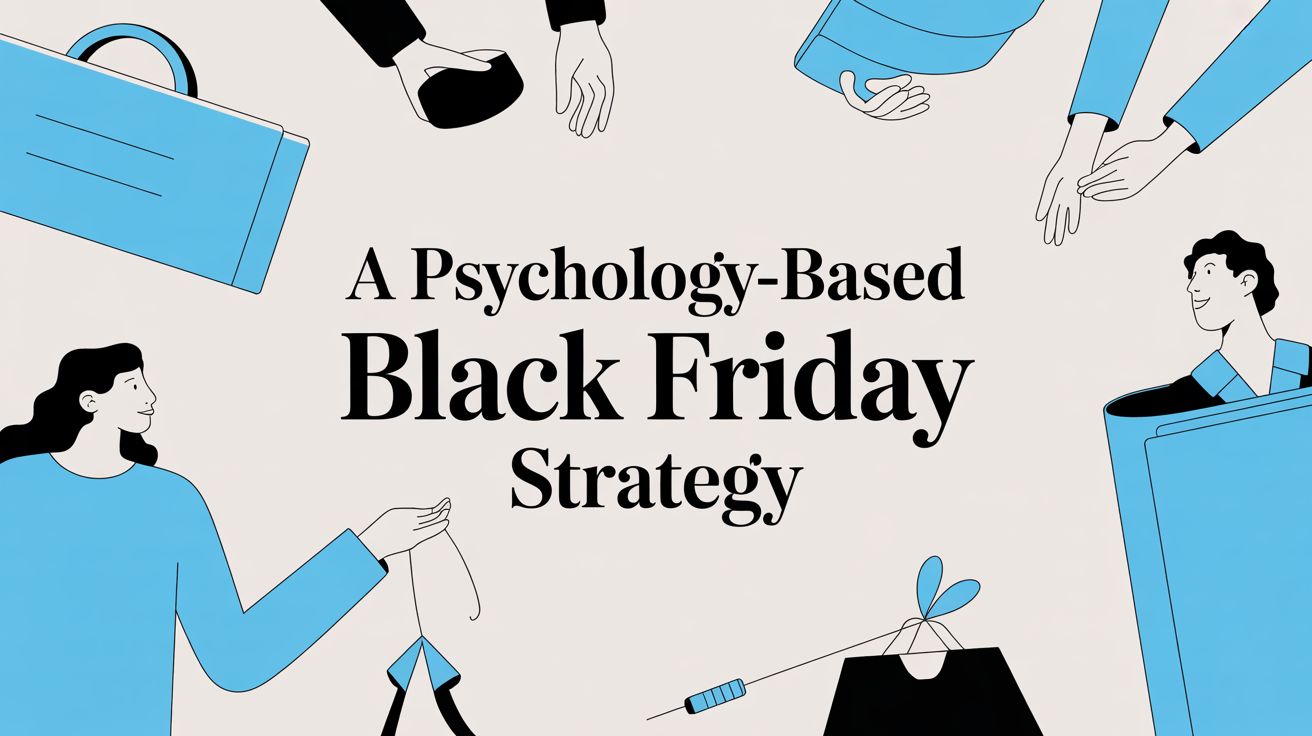
A winning Black Friday strategy isn’t about who can scream the loudest with the deepest discounts anymore. It's a much more sophisticated game now, one deeply rooted in behavioral psychology. By understanding what really makes shoppers tick—the principles of scarcity, anticipation, and social proof—brands can drive massive revenue and actually protect their profit margins without cheapening their products.
Beyond Discounts: A Modern Black Friday Strategy
The old Black Friday playbook of "slash prices and pray for volume" is not just getting tired; it's actively damaging your bottom line. Today's shoppers are smart, but they're also human. They're wired with powerful psychological triggers that a simple percentage-off deal just can't compete with. An effective Black Friday strategy isn't a race to the bottom on price. It's about creating a series of high-impact 'moments' that resonate, grounded in the science of consumer psychology.
These moments are designed to tap directly into fundamental behavioral principles. Grasping these drivers is the first real step toward building a holiday sales plan that’s both profitable and sustainable.
- Anticipation: Build a groundswell of excitement before the sale even starts. This psychological principle creates a ready-made pool of high-intent buyers who are just waiting for the green light.
- Scarcity: Limited inventory or time-boxed offers trigger a very real fear of missing out (FOMO). Behavioral economics research consistently shows this is a powerful motivator because it signals high value and prompts immediate action.
- Social Proof: When you show how many other people are looking at or buying a product, it instantly lowers the barrier to purchase. It’s a psychological shortcut that says, "Hey, others approve of this, so you're making a good choice."
Shifting from Price to Psychology
The mission is to elevate the entire customer journey, from the very first ad they see to that final, satisfying click at checkout. It means ditching generic countdown timers for dynamic, personalized urgency. It means swapping out basic email-capture popups for campaigns that actually generate revenue on the spot.
This isn't about manipulation. It's about using urgency as a sophisticated tool to guide consumer behavior in a way that feels helpful and exciting.
Consider this: recent data showed that while the average Black Friday discount was between 11% and 23%, a huge number of non-discounted items also saw a major sales lift. That tells you the event itself creates a mindset to buy that isn't solely dependent on a markdown. It’s about capitalizing on that broader buying intent.
Focusing on these psychological triggers creates a far more engaging shopping environment that not only drives conversions but also supports your bigger business goals.
A psychology-driven Black Friday strategy is an essential tool for both revenue generation and operational efficiency. It allows for strategic inventory management—clearing out overstocked items with targeted flash sales or building hype for new arrivals with exclusive access—all while protecting profit margins.
To really see the difference, it helps to compare the old way of thinking with this more modern, psychology-based approach. The impact on key metrics is stark.
Traditional vs Psychology-Driven Black Friday Strategies
| Metric | Traditional Strategy (Deep Discounts) | Psychology-Driven Strategy (Intelligent Urgency) |
|---|---|---|
| Profit Margins | Severely eroded by site-wide sales | Protected through targeted, strategic offers |
| Customer Loyalty | Attracts one-off deal hunters | Builds excitement and long-term engagement |
| Brand Perception | Devalued, seen as a "discount" brand | Positioned as premium and in-demand |
| Inventory Management | Unpredictable, can lead to stockouts or dead stock | Strategic, moves specific SKUs with precision |
| Average Order Value (AOV) | Often lower, focused on the cheapest items | Higher, encourages bundling and full-price purchases |
The table makes it clear: moving away from a pure discount model isn't just a trend, it's a fundamental shift toward a more profitable and sustainable business. It's about building a brand, not just moving units.
The Impact on Your Business
When you adopt this modern approach, the impact on your ROI is direct and measurable. By sidestepping those margin-crushing, site-wide sales, you can roll out more nuanced incentives that push up average order values and build real, long-term customer loyalty.
For merchants on platforms like Shopify Plus, this level of strategic automation is mission-critical. You need to handle enterprise-level traffic without your site crashing or your profitability tanking. When you integrate sophisticated psychological triggers with tools like Klaviyo or your SMS platform, you can orchestrate a seamless, multi-channel campaign that feels both personal and incredibly compelling.
Ultimately, the most successful brands have figured out that a Black Friday strategy built on behavioral science delivers far better financial results than one built only on discounts. You can explore a variety of marketing incentives other than discounts to add to your marketing that will keep customers engaged and your bottom line healthy.
Building Anticipation Before the Sale
A winning Black Friday strategy doesn’t kick off on Thanksgiving morning. It actually starts weeks, sometimes even months, in advance.
The real goal isn't just to compete on price—that’s a race to the bottom. It's about competing on excitement. This means you need to methodically build anticipation, turning passive window shoppers into an engaged audience that’s ready to buy the second your deals drop. This pre-launch phase is where you win the battle for attention before the sales war even begins.
This whole approach is grounded in a core psychological principle: anticipation. Consumer psychology studies show that when people look forward to something, the feeling of anticipation itself can be as satisfying as the reward. By creating a compelling pre-sale experience, you’re not just warming up leads; you’re cementing your brand into their holiday shopping plans.
We've seen Black Friday evolve, too. Last year, over 60% of Black Friday shoppers started buying before Thanksgiving even rolled around. This tells us the shopping window is spreading out, which is great for easing logistical pressure and capturing more sales. If you want to dive deeper into the numbers, Printful.com has some great Black Friday statistics and insights.
Cultivating an Engaged VIP Audience
Your first move should be to build a segmented VIP list. This isn't just about a generic "sign up for our newsletter" pop-up designed for email capture. This is about creating an exclusive club to drive revenue. Your most valuable customers—the ones who've bought before, your loyal followers, your most engaged subscribers—deserve to be treated differently.
Use the tools you already have, like Klaviyo or your favorite SMS platform, to carve out these specific segments. The message needs to be crystal clear: join our VIP list for exclusive early access to Black Friday deals. This taps directly into the human desire for status and exclusivity, which are far more powerful motivators than a simple discount.
This is all about shifting from a price-focused strategy to one centered on psychological engagement. That’s the key to building real anticipation.
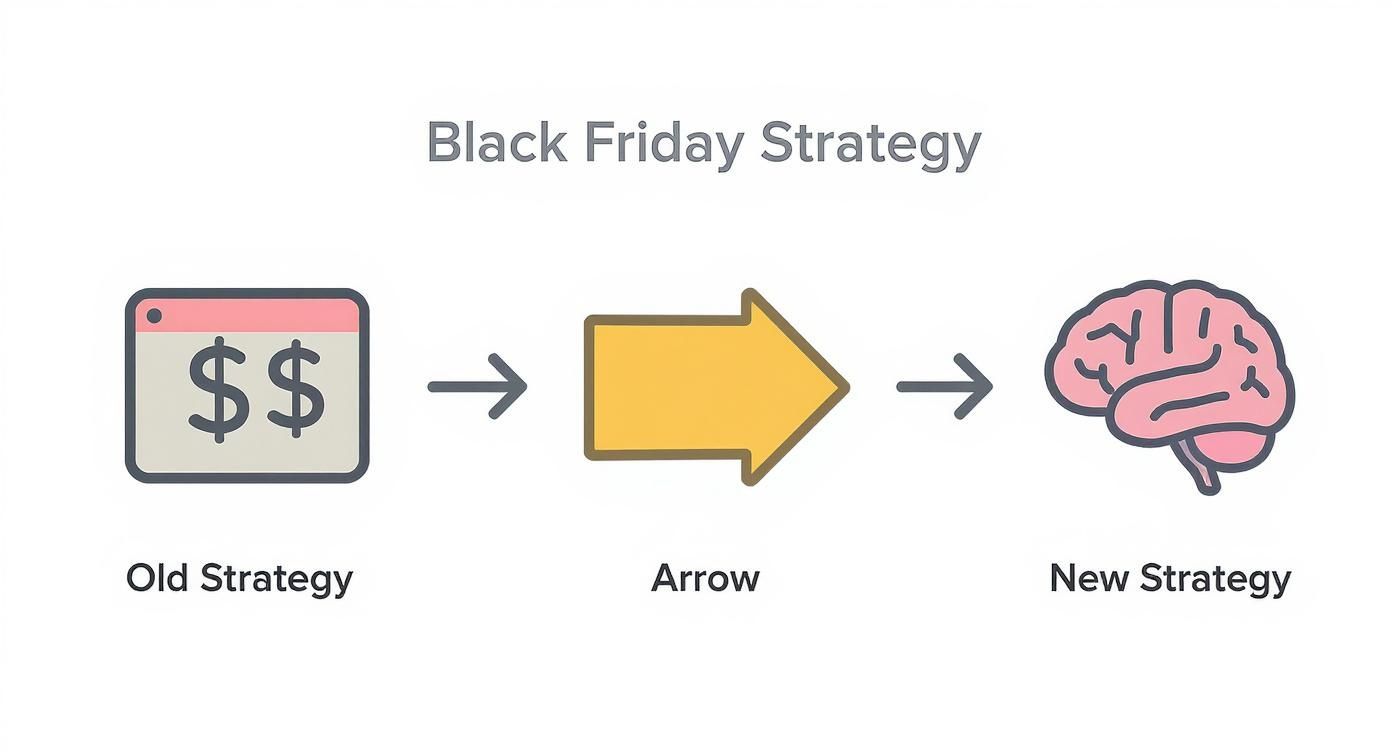
As you can see, modern success isn't about just slashing prices anymore (the old way). It’s about using smart consumer psychology to get better, more profitable results.
Moving Beyond Basic Countdown Timers
While a basic countdown timer on your homepage can create a general sense of urgency, it lacks strategic depth and personalization. A much more effective approach involves creating automated, moment-based campaigns that deliver genuine, exclusive value. Instead of one big, site-wide launch, think about orchestrating a series of special "Moments" just for your VIPs.
Here’s an actionable takeaway you can implement immediately:
- Teaser Campaigns: Start sending emails and SMS messages that hint at specific product categories or doorbuster deals. Don't give everything away at once. Build curiosity.
- Staggered Early Access: Don't let everyone in at the same time. Maybe your highest lifetime value (LTV) customers get access a full 24 hours before everyone else, while your regular VIPs get a 12-hour head start.
- Personalized "Moment" Invitations: A platform like Quikly excels here, positioning our team as experts in the science of urgency. It allows you to create time-sensitive opportunities where the fastest people to respond get the absolute best offers. This gamified approach transforms a passive wait into an active, fun, and engaging event.
By focusing on anticipation, you shift the customer's mindset from "How much can I save?" to "What will I get to be a part of?" This re-framing is critical for protecting brand equity and profit margins during a traditionally discount-heavy period. You can find more on this in our extensive guide to consumer anticipation.
This strategy turns your Black Friday event from a simple sale into an exclusive experience. For merchants on Shopify Plus, automating these segmented campaigns is essential for managing enterprise-level traffic and ensuring a flawless user experience.
The result? You get a high-velocity start to your sale, driven by your most loyal customers. This creates powerful social proof and momentum that will carry you through the entire weekend.
Driving Conversions During Peak Traffic
The moment of truth has arrived. All your hard work building hype for Black Friday has paid off, and the traffic is pouring in. Now, your website is a high-stakes environment where every single click is critical.
This is where your strategy pivots—from building anticipation to driving sales with laser-like focus. Getting traffic is one thing, but converting that surge into actual revenue is the real goal. With the average e-commerce store converting at just 2.5%, and the industry benchmark for cart abandonment at 70%, you need to blow past those numbers.
The trick is to create a dynamic shopping experience, one that intelligently nudges visitors toward the checkout. We're not talking about a generic, site-wide countdown timer. That's just noise. We need to get more sophisticated with behavior-triggered urgency that feels genuinely helpful to each shopper.
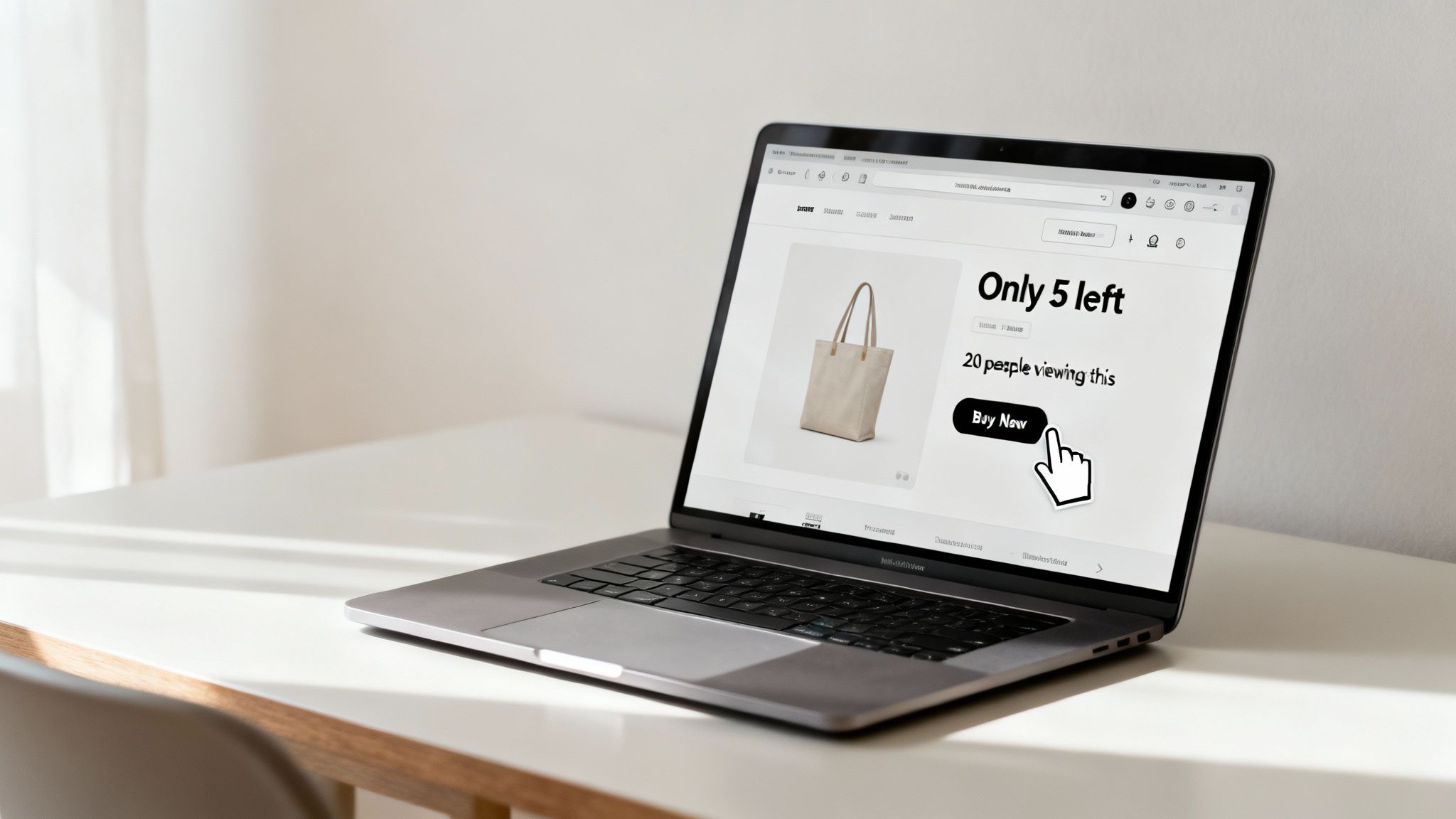
From Basic Popups to Behavioral Triggers
A customer on your site during Black Friday has high purchase intent. So why hit them with a generic popup just to grab their email? That’s a massive missed opportunity that prioritizes list growth over revenue. Your primary goal is to close the sale. This requires applying consumer psychology and leveraging triggers based on what people are actually doing on your site in real time.
Here are a couple of practical, psychology-driven scenarios you can implement:
- Triggered Scarcity: Instead of a "low stock" banner on every product page (which people start to ignore), only show it to users who have viewed a specific item multiple times or added it to their cart. This targeted use of the Scarcity Principle feels like a helpful, personalized heads-up, not a marketing slogan.
- Segmented Flash Moments: Launch a surprise flash sale—what we at Quikly call a "Moment"—but only on a product category that your data shows is underperforming. It's a surgical strike. You clear out specific inventory while creating a fun, gamified experience for a select group of customers.
This is the kind of sophisticated automation that separates a modern Black Friday strategy from an outdated, manual one. It lets you react instantly to shopper behavior at scale, without needing someone to watch the analytics screen 24/7.
Implementing Dynamic Urgency on Shopify
If you're running on Shopify, especially an enterprise-level Shopify Plus store, you know that site performance during a traffic spike is everything. The last thing you want is for a third-party script to slow down your site, kill the user experience, and tank your conversions.
Modern urgency platforms are built for this. Quikly is designed to integrate seamlessly, using server-side logic that barely impacts load times. When you’re vetting a tool, make sure it plays nice with your existing marketing stack, like Klaviyo for email or your go-to SMS platform. This way, you can create a truly cohesive journey—an on-site urgency message gets reinforced by a perfectly timed text or email, guiding that customer smoothly to checkout.
For a deeper dive, our guide on Shopify-specific urgency tactics has more detailed advice on implementation.
The average cart abandonment rate is a staggering 70%. When you strategically use social proof and scarcity, you aren't just manipulating shoppers. You're giving them valuable context that helps them cut through decision paralysis and complete their purchase with confidence.
The Science of Social Proof and Scarcity
Behavioral economics has proven time and again that we’re heavily influenced by what others are doing (social proof) and the fear of missing out (scarcity). Basic timers create some urgency, but they don't tap into these deeper psychological drivers nearly as well.
Here’s how you can apply them with more finesse:
- Social Proof: Don’t just show star ratings. Display dynamic messages like, "20 people are viewing this item" or "Purchased 5 times in the last hour." This creates the feeling of a bustling, popular store, which validates a shopper's interest and makes them feel safer about their decision.
- Scarcity: Don’t just rely on one tactic. Combine limited-quantity alerts ("Only 5 left at this price") with a time-based limit ("Offer ends in 00:15:00"). The combination of the two is far more powerful than either one alone, compelling people to act decisively.
Beyond just getting eyeballs on your site, the ultimate goal is to figure out how to improve your website's conversion rate and turn those visitors into loyal customers. By grounding your Black Friday strategy in the science of consumer behavior, you can build a system that doesn't just grab attention but converts it into real, sustainable revenue.
Protecting Profit Margins and Managing Inventory
A successful Black Friday is about more than just eye-popping revenue numbers. It's about profitability. The pressure to roll out massive, site-wide discounts can quickly eat away at your margins, turning what looks like a great sales day into a financial headache.
This is where a smart urgency marketing plan becomes your secret weapon.
Instead of just slapping a generic discount on everything, the idea is to use targeted, time-sensitive offers with surgical precision. This approach elevates urgency from a simple sales gimmick to a powerful tool for inventory management and bottom-line protection. It's about directly connecting your marketing to your financial health.
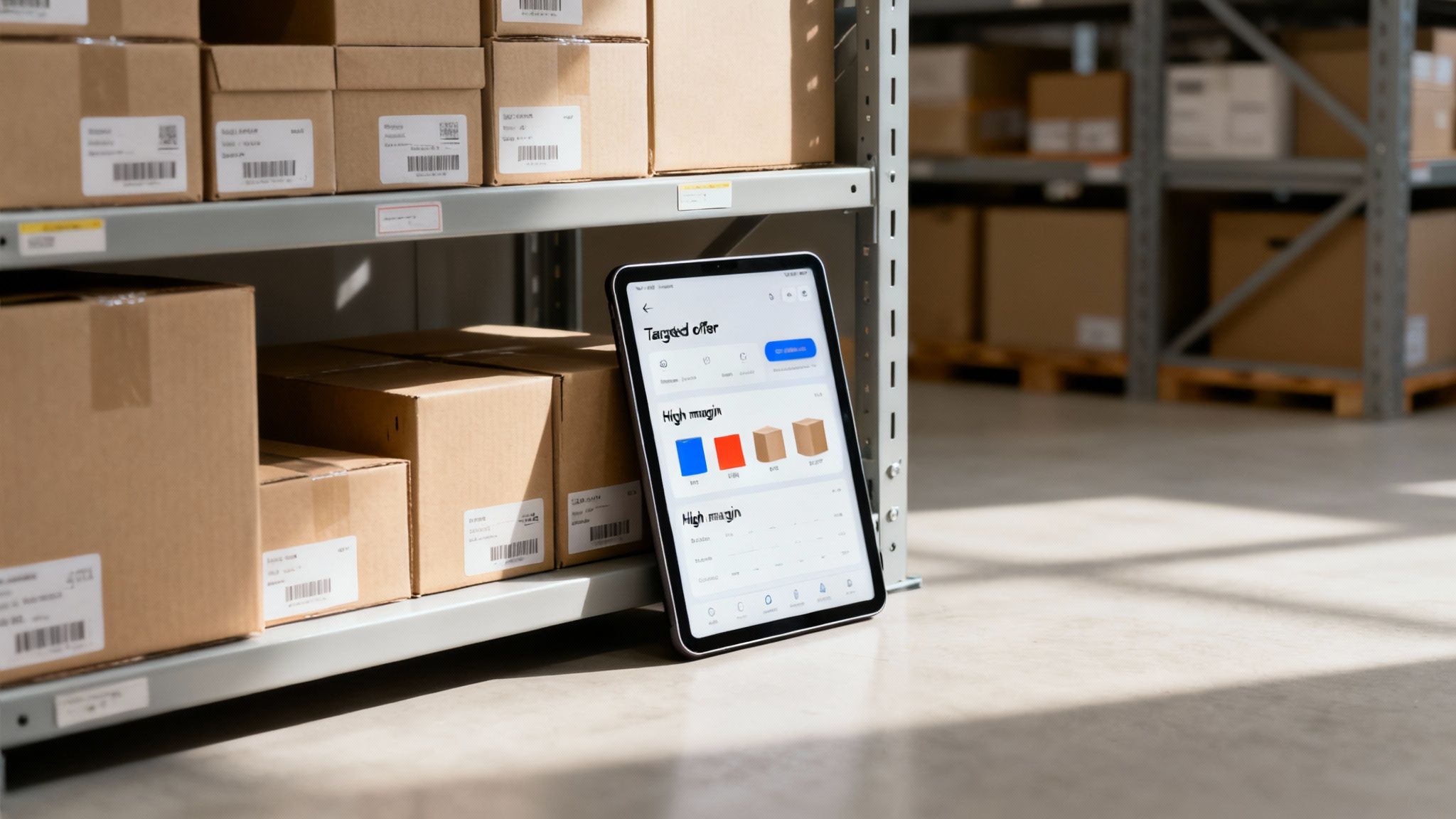
A Framework for Strategic Inventory Segmentation
First, you need to segment your inventory—not by product type, but by its strategic role in your business. Each segment needs a different kind of psychological nudge to sell well without gutting your profits. This is miles ahead of a basic "10% off" popup.
Think of your product catalog in these distinct buckets:
- Excess Inventory (Overstocked Items): These are products tying up cash. The mission is liquidation, but without looking desperate.
- High-Margin Heroes: Your bread and butter. These are your most profitable items, and the goal is to sell as many as possible at or very close to full price.
- New Arrivals & Testers: You need to see if these have legs. The objective here is to get early sales velocity and valuable customer feedback.
- Traffic Drivers (Basket Openers): These are the popular, well-priced items that get people in the door. The goal is to use them to bulk up the average order value.
By sorting your inventory this way, you can ditch the one-size-fits-all approach for a much more nuanced, profit-focused plan.
Aligning Urgency Tactics with Business Goals
Once you have your inventory segmented, you can start matching the right urgency tactic to the right group. This is where you see the psychology of consumer behavior directly impact your ROI. We're moving beyond a generic countdown timer and deploying specific behavioral triggers to get a specific result.
For that excess inventory, a "limited quantity" alert or a flash "Moment" campaign creates a genuine feeling of scarcity. This taps into the psychological principle that we place a higher value on things that are about to disappear. It drives immediate action to clear out that stock without you having to slash prices across the board.
For your high-margin heroes, urgency should be used to build value, not discount it. Try these actionable tactics:
- Offering a great gift-with-purchase for the first 100 buyers.
- Bundling a high-margin product with a smaller, complementary item for a limited time.
- Using social proof with messages like "Selling fast!" to reinforce that it's a premium, in-demand item.
A targeted urgency strategy lets you keep the perceived value of your core products high while strategically clearing out specific SKUs. This protects your brand and prevents the long-term damage that comes from training customers to just wait for the next big sale.
If you're a Shopify Plus merchant, you can automate this kind of advanced segmentation. By integrating with a platform like Klaviyo, you can build dynamic customer segments based on past purchases. Then, you can hit them with specific, time-bound offers via email and SMS, ensuring the perfect message gets to the right person for the right product.
Ultimately, this intelligent approach to your Black Friday strategy means you aren't just moving units. You’re actively shaping demand, managing your inventory with purpose, and—most importantly—protecting the profitability that makes a sales event truly successful.
Analyzing Performance for Post-Sale Optimization
The final checkout click on Black Friday doesn't mean your work is done. It is the starting line for your next big optimization cycle. The data you've just collected is a goldmine of psychological insights that will directly shape your Cyber Monday and end-of-year sales strategy.
To get it right, you have to move beyond surface-level metrics. It’s crucial to understand the true ROI of your campaigns and start building a smarter Black Friday playbook for next year.
Moving Beyond Conversion Rate
Conversion rate is a good starting point, but it only tells a fraction of the story. A truly insightful analysis dives into the financial and behavioral impact of your urgency campaigns. This means digging deeper into metrics that reveal customer quality and profitability, not just how many transactions you pushed through.
Here are the numbers you should be focusing on:
- Average Order Value (AOV): Did your urgency tactics, like bundling or tiered offers, actually encourage customers to add more to their carts? Compare this against shoppers who just used a simple discount.
- Customer Lifetime Value (LTV): Are the customers you acquired through high-urgency "flash sale" moments coming back to buy again? This tells you if you're attracting loyal fans or just one-time deal hunters.
- Profit Margin Per Sale: Get granular here. Compare the profitability of sales driven by targeted scarcity alerts ("Only 5 left!") versus those from a generic, site-wide discount. This is the ultimate test of a healthy sales event.
By focusing on these deeper metrics, you shift from simply making sales to making smart sales. You'll pinpoint which urgency triggers attract high-value customers, directly influencing where you put your marketing dollars next time.
The scale is massive. This past year, global online sales hit a staggering $74.4 billion. What's more, a massive 55% of these purchases were made on mobile devices, hammering home just how critical a seamless mobile experience is.
Interpreting the Data for Actionable Insights
Once you have the numbers, the real work begins: turning that data into concrete improvements. The goal is to spot patterns in how your customers behave.
For example, you might discover that limited-quantity alerts on your big-ticket items dramatically outperformed a simple countdown timer. This tells you your audience responds more to the fear of missing out on a specific product (scarcity) than a general deadline (time pressure).
This process lets you refine your approach almost in real-time. If you see that an early-access campaign for your VIP list resulted in a 30% higher AOV, you know to double down on that strategy for your upcoming holiday sales. To get a broader perspective, it's always smart to analyze past BFCM trends and statistics.
For merchants using platforms like Shopify Plus, this kind of analysis is much easier thanks to their robust reporting tools. You can create custom reports to segment customers acquired through specific urgency campaigns, track what they do next, and even sync that data with tools like Klaviyo to build powerful, long-term retention strategies.
To truly understand the impact of your campaigns, it helps to track a variety of metrics that tell a complete story.
Key Metrics for Evaluating Black Friday Success
This table breaks down the essential metrics you should be analyzing. Moving beyond simple conversion rates will give you a much clearer picture of the true business impact of your strategy.
| Metric | What It Tells You | Optimization Goal |
|---|---|---|
| Average Order Value (AOV) | The average amount spent per order. | Increase by promoting bundles, upsells, or tiered discounts. |
| Customer Lifetime Value (LTV) | The total revenue a customer is expected to generate over time. | Identify which campaigns acquire customers who make repeat purchases. |
| Profit Margin Per Sale | The profitability of each transaction after costs. | Prioritize high-margin products and urgency tactics that don't rely on deep discounts. |
| Cart Abandonment Rate | The percentage of shoppers who add items but don't complete the purchase. | Identify friction points in the checkout process, especially on mobile. |
| New vs. Returning Customers | The ratio of first-time buyers to repeat customers. | Balance acquisition with retention; see if your deals appeal to both segments. |
| Traffic Source Performance | Which channels (email, social, PPC) drove the most valuable traffic. | Allocate future ad spend to the channels that deliver the highest ROI, not just clicks. |
By tracking these KPIs, you can move from reactive decision-making to a proactive strategy built on a solid foundation of data.
Setting the Stage for Future Success
Think of your post-Black Friday analysis as the blueprint for your next big sales event. By understanding which psychological triggers delivered the highest ROI, you can stop guessing and start making decisions backed by hard evidence.
This is how you evolve. It's how your Black Friday strategy gets more effective and more profitable, year after year.
Black Friday FAQs
Got questions? We've got answers. Here are some of the most common things brand leaders ask about shifting to a modern, psychology-backed Black Friday strategy.
How Can I Create Urgency Without Feeling Sleazy?
This is a big one. The difference between powerful psychological marketing and shady manipulation comes down to one thing: authenticity.
You are not trying to deceive anyone. You are enhancing their shopping experience by giving them timely, helpful information that also happens to create some excitement.
Think about it this way:
- Real Scarcity: Is an item actually low in stock? Telling a customer "Only 7 left" isn't a trick; it's valuable information that helps them make a decision.
- Time-Bound Value: Are you offering early VIP access or an exclusive bundle that genuinely expires? That's a real benefit tied to a real deadline.
- Helpful Nudges: Notifying a shopper that an item in their cart is almost gone isn't just about scarcity—it's good customer service. You're saving them from the disappointment of a sold-out product.
The line gets crossed when you get into fake countdown timers, inflated "before" prices, and made-up scarcity claims. Stick to the truth, provide real value, and you'll build trust while driving profitable sales.
Are These Strategies Only For Big Shopify Plus Stores?
Absolutely not. While massive Shopify Plus stores use these tactics at a huge scale, the psychological principles are universal. They work for a five-person team just as well as they do for a 500-person enterprise.
The beauty of this approach is how scalable it is.
If you're on a smaller Shopify plan, you don't need to do everything at once. Start simple. Launch a VIP early access campaign using your current email provider, like Klaviyo. Or, use a simple app to add dynamic low-stock alerts just to your top three bestsellers.
The goal is to start small, measure the direct impact on your revenue and margins, and then reinvest in what works. Consumer psychology doesn't care how big your store is.
How Do I Wean My Customers Off Constant Discounts?
You don't have to go cold turkey. In fact, that's probably a bad idea if your audience is used to constant sales. The key is a gradual transition where you start combining your discounts with powerful urgency triggers. You're basically retraining your audience.
Here's a simple roadmap:
- Contain Your Discounts: Instead of a week-long, site-wide 30% off sale, try a 48-hour flash sale at 30% off, but only on a specific product category. Now you’ve introduced time pressure.
- Add Scarcity Incentives: Next, try a "free gift with purchase" offer for the first 100 orders. This taps into scarcity and social proof without cheapening your products.
- Talk About the Shift: Use your email and SMS lists to frame these as exciting, time-sensitive "events" or "drops." The language you use matters.
Over time, your customers will stop waiting passively for the next big markdown and start looking forward to these more engaging campaigns. It's a strategic way to claw back your margins.
How Do I Actually Measure the ROI of an Urgency Campaign?
You have to get past the vanity metrics. To really know if this is working, you need to isolate the direct impact your campaigns have on profitable revenue.
The single most important thing you can do is compare the profit margins on sales from your targeted urgency campaigns versus sales from your old sitewide discounts. That's where the truth lies.
To get clean data, you need to set up your tracking properly:
- Isolate Your Traffic: Use unique UTM parameters for every link in your urgency-based emails, SMS messages, and social ads. No exceptions.
- Define Your Goals: In your analytics platform, set up specific conversion goals for actions tied to your on-site banners, popups, or special "Moment" campaigns.
- A/B Test Everything: Whenever you can, run an A/B test. Show an urgency message to one group and nothing to a control group. It's the only way to know the true lift in conversion rate and Average Order Value (AOV).
This data-driven approach gives you a clear picture of whether you're building a healthier business or just chasing empty revenue.
Ready to see how the science of urgency can transform your Black Friday? See how Quikly helps you create high-impact moments that drive revenue, protect your margins, and get customers genuinely excited. Explore what Quikly can do for your brand.

The Quikly Content Team brings together urgency marketing experts, consumer psychologists, and data analysts who've helped power promotional campaigns since 2012. Drawing from our platform's 70M+ consumer interactions and thousands of successful campaigns, we share evidence-based insights that help brands create promotions that convert.
